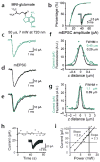Dendritic spine geometry is critical for AMPA receptor expression in hippocampal CA1 pyramidal neurons
- PMID: 11687814
- PMCID: PMC4229049
- DOI: 10.1038/nn736
Dendritic spine geometry is critical for AMPA receptor expression in hippocampal CA1 pyramidal neurons
Abstract
Dendritic spines serve as preferential sites of excitatory synaptic connections and are pleomorphic. To address the structure-function relationship of the dendritic spines, we used two-photon uncaging of glutamate to allow mapping of functional glutamate receptors at the level of the single synapse. Our analyses of the spines of CA1 pyramidal neurons reveal that AMPA (alpha-amino-3-hydroxy-5-methyl-4-isoxazolepropionic acid)-type glutamate receptors are abundant (up to 150/spine) in mushroom spines but sparsely distributed in thin spines and filopodia. The latter may be serving as the structural substrates of the silent synapses that have been proposed to play roles in development and plasticity of synaptic transmission. Our data indicate that distribution of functional AMPA receptors is tightly correlated with spine geometry and that receptor activity is independently regulated at the level of single spines.
Figures






Comment in
-
Illuminating the location of brain glutamate receptors.Nat Neurosci. 2001 Nov;4(11):1051-2. doi: 10.1038/nn1101-1051. Nat Neurosci. 2001. PMID: 11687808 No abstract available.
References
-
- Bliss TV, Collingridge GL. A synaptic model of memory: long-term potentiation in the hippocampus. Nature. 1993;361:31–39. - PubMed
-
- Malenka RC, Nicoll RA. Long-term potentiation—a decade of progress? Science. 1999;285:1870–1874. - PubMed
-
- Ziff EB. Enlightening the postsynaptic density. Neuron. 1997;19:1163–1174. - PubMed
Publication types
MeSH terms
Substances
Grants and funding
LinkOut - more resources
Full Text Sources
Other Literature Sources
Miscellaneous

